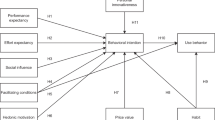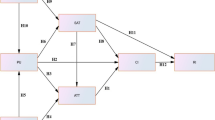Abstract
ChatGPT, an AI language model, has gained significant attention for its potential to enhance educational experiences and foster interactive learning environments. The potential of student interaction via ChatGPT has engendered significant debate around educational technology. It is apparent that the current literature has yet to fully explore the role of ChatGPT in management education. Amidst the increasing integration of ChatGPT into educational contexts, the concept of continuance intention takes center stage. This research paper delves into the nuanced landscape of students’ continuance intention regarding the use of ChatGPT in educational settings. We ground our study in Technology Continuance Theory and Theory of Planned Behavior to examine students’ continuance intention to use ChatGPT. By investigating the determinants that shape this intention, we aim to provide insights that inform educators and educational technology designers in optimizing the integration of AI-driven tools like ChatGPT. This study contributes to the growing body of research at the intersection of AI and education, offering valuable implications for both theory and practice.
Access this chapter
Tax calculation will be finalised at checkout
Purchases are for personal use only
Similar content being viewed by others
References
Liebrenz, M., Schleifer, R., Buadze, A., Bhugra, D., Smith, A.: Generating scholarly content with ChatGPT: ethical challenges for medical publishing. The Lancet Digital Health 5(3), e105–e106 (2023). https://doi.org/10.1016/S2589-7500(23)00019-5
Dwivedi, Y.K., et al.: Opinion Paper: “So what if ChatGPT wrote it?” multidisciplinary perspectives on opportunities, challenges and implications of generative conversational AI for research, practice and policy. Int. J. Inf. Manage. 71, 102642 (2023). https://doi.org/10.1016/j.ijinfomgt.2023.102642
Baidoo-Anu, D., Owusu Ansah, L.: Education in the Era of Generative Artificial intelligence (AI): understanding the potential benefits of ChatGPT in promoting teaching and learning. Journal of AI 7(1), 52–62 (2023)
Jovanovic, M., Campbell, M.: Generative artificial intelligence: trends and prospects. Computer 55(10), 107–112 (2022). https://doi.org/10.1109/MC.2022.3192720
Abukmeil, M., Ferrari, S., Genovese, A., Piuri, V., Scotti, F.: A survey of unsupervised generative models for exploratory data analysis and representation learning. ACM Comput. Surv. 54(5), 1–40 (2022). https://doi.org/10.1145/3450963
Milmo, D.: ChatGPT reaches 100 million users two months after launch. The Guardian (2023). https://www.theguardian.com/technology/2023/feb/02/chatgpt-100-million-users-open-ai-fastest-growing-app
Ratten, V., Jones, P.: Generative artificial intelligence (ChatGPT): implications for management educators. The International J. Manage. Educ. 21(3), 100857 (2023). https://doi.org/10.1016/j.ijme.2023.100857
Statista: Share of company employees worldwide using ChatGPT in work environments from February to March 2023 (2023). https://www.statista.com/statistics/1378709/global-employees-chatgpt-se/
Goralski, M.A., Tan, T.K.: Artificial intelligence and poverty alleviation: emerging innovations and their implications for management education and sustainable development. The Int. J. Manage. Educ. 20(3), 100662 (2022). https://doi.org/10.1016/j.ijme.2022.100662
Dowling, M., Lucey, B.: ChatGPT for (Finance) research: the Bananarama Conjecture. Financ. Res. Lett. 53, 103662 (2023). https://doi.org/10.1016/j.frl.2023.103662
Kung, T.H., et al.: Performance of ChatGPT on USMLE: potential for AI-assisted medical education using large language models. PLOS Digit Health 2(2), e0000198 (2023). https://doi.org/10.1371/journal.pdig.0000198
Pavlou and Fygenson: Understanding and predicting electronic commerce adoption: an extension of the theory of planned behavior. MIS Q. 30(1), 115 (2006). https://doi.org/10.2307/25148720
Firat, M.: How chat GPT can transform autodidactic experiences and open education?. Open Science Framework, preprint (2023). https://doi.org/10.31219/osf.io/9ge8m
Keiper, M.C., Fried, G., Lupinek, J., Nordstrom, H.: Artificial intelligence in sport management education: playing the AI game with ChatGPT. J. Hosp. Leis. Sport Tour. Educ. 33, 100456 (2023). https://doi.org/10.1016/j.jhlste.2023.100456
Fesenmaier, D.R., Wöber, K.: AI, ChatGPT and the university. Ann. Tour. Res. 101, 103578 (2023). https://doi.org/10.1016/j.annals.2023.103578
King, M.R., chatGPT: A conversation on artificial intelligence, chatbots, and plagiarism in higher education. Cel. Mol. Bioeng. 16(1), 1–2 (2023). https://doi.org/10.1007/s12195-022-00754-8
Cotton, D.R.E., Cotton, P.A., Shipway, J.R.: Chatting and cheating: Ensuring academic integrity in the era of ChatGPT. Innovations in Education and Teaching International, pp. 1–12 (2023). https://doi.org/10.1080/14703297.2023.2190148
Foroughi, B., Iranmanesh, M., Hyun, S.S.: Understanding the determinants of mobile banking continuance usage intention. JEIM 32(6), 1015–1033 (2019). https://doi.org/10.1108/JEIM-10-2018-0237
Khayer, A., Bao, Y.: The continuance usage intention of Alipay: Integrating context-awareness and technology continuance theory (TCT). BL 32(3), 211–229, (2019). https://doi.org/10.1108/BL-07-2019-0097
Gilani, M.S., Iranmanesh, M., Nikbin, D., Zailani, S.: EMR continuance usage intention of healthcare professionals. Inform. Health Soc. Care 42(2), 153–165 (2017). https://doi.org/10.3109/17538157.2016.1160245
Weng, G.S., Zailani, S., Iranmanesh, M., Hyun, S.S.: Mobile taxi booking application service’s continuance usage intention by users. Transp. Res. Part D: Transp. Environ. 57, 207–216 (2017). https://doi.org/10.1016/j.trd.2017.07.023
Bhattacherjee, A., Perols, J., Sanford, C.: Information technology continuance: a theoretic extension and empirical test. J. Computer Information Syst. 49(1), 17–26 (2008). https://doi.org/10.1080/08874417.2008.11645302
Jain, N.K., Kaul, D., Sanyal, P.: What drives customers towards mobile shopping? an integrative technology continuance theory perspective. APJML 34(5), 922–943 (2022). https://doi.org/10.1108/APJML-02-2021-0133
Rahi, S., Khan, M.M., Alghizzawi, M.: Extension of technology continuance theory (TCT) with task technology fit (TTF) in the context of Internet banking user continuance intention. IJQRM 38(4), 986–1004 (2020). https://doi.org/10.1108/IJQRM-03-2020-0074
Ajzen, I.: The theory of planned behavior. Organ. Behav. Hum. Decis. Process. 50(2), 179–211 (1991). https://doi.org/10.1016/0749-5978(91)90020-T
Conner, M., Armitage, C.J.: Extending the theory of planned behavior: a review and avenues for further research. J. Appl. Social Pyschol. 28(15), 1429–1464 (1998). https://doi.org/10.1111/j.1559-1816.1998.tb01685.x
George, J.F.: The theory of planned behavior and Internet purchasing. Internet Res. 14(3), 198–212 (2004). https://doi.org/10.1108/10662240410542634
Morris, M.G., Venkatesh, V., Ackerman, P.L.: Gender and age differences in employee decisions about new technology: an extension to the theory of planned behavior. IEEE Trans. Eng. Manage. 52(1), 69–84 (2005). https://doi.org/10.1109/TEM.2004.839967
Yadav, J., Misra, M., Rana, N.P., Singh, K., Goundar, S.: Netizens’ behavior towards a blockchain-based esports framework: a TPB and machine learning integrated approach. IJSMS 23(4), 665–683 (2022). https://doi.org/10.1108/IJSMS-06-2021-0130
Davis, F.D.: Perceived usefulness, perceived ease of use, and user acceptance of information technology. MIS Q. 13(3), 319 (1989). https://doi.org/10.2307/249008
Yan, M., Filieri, R., Gorton, M.: Continuance intention of online technologies: a systematic literature review. Int. J. Inf. Manage. 58, 102315 (2021). https://doi.org/10.1016/j.ijinfomgt.2021.102315
Yan, M., Filieri, R., Raguseo, E., Gorton, M.: Mobile apps for healthy living: Factors influencing continuance intention for health apps. Technol. Forecast. Soc. Chang. 166, 120644 (2021). https://doi.org/10.1016/j.techfore.2021.120644
Bhattacherjee, A.: Understanding information systems continuance: an expectation-confirmation model. MIS Q. 25(3), 351 (2001). https://doi.org/10.2307/3250921
Al Amin, M., Arefin, M.S., Sultana, N., Islam, M.R., Jahan, I., Akhtar, A.: Evaluating the customers’ dining attitudes, e-satisfaction and continuance intention toward mobile food ordering apps (MFOAs): evidence from Bangladesh. EJMBE 30(2), 211–229 (2021). https://doi.org/10.1108/EJMBE-04-2020-0066
Huang, C.-K., Chen, C.-D., Liu, Y.-T.: To stay or not to stay? discontinuance intention of gamification apps. ITP 32(6), 1423–1445 (2019). https://doi.org/10.1108/ITP-08-2017-0271
Liao, C., Palvia, P., Chen, J.-L.: Information technology adoption behavior life cycle: toward a technology continuance theory (TCT). Int. J. Inf. Manage. 29(4), 309–320 (2009). https://doi.org/10.1016/j.ijinfomgt.2009.03.004
Ajzen, I., Fishbein, M.: Attitude-behavior relations: A theoretical analysis and review of empirical research. Psychological Bulletin 84(5), 888–918 (1977). https://doi.org/10.1037/0033-2909.84.5.888
Venkatesh, V., Davis, F.D.: A theoretical extension of the technology acceptance model: four longitudinal field studies. Manage. Sci. 46(2), 186–204 (2000). https://doi.org/10.1287/mnsc.46.2.186.11926
Kock, N.: Common method bias in PLS-SEM: a full collinearity assessment approach. International J. e-Collaboration 11(4), 1 (2015). https://doi.org/10.4018/ijec.2015100101
Podsakoff, P.M., MacKenzie, S.B., Lee, J.-Y., Podsakoff, N. P.: Common method biases in behavioral research: A critical review of the literature and recommended remedies. Journal of Applied Psychology 88(5), 879–903 (2003). https://doi.org/10.1037/0021-9010.88.5.879
Côrte-Real, N., Ruivo, P., Oliveira, T.: Leveraging internet of things and big data analytics initiatives in European and American firms: Is data quality a way to extract business value? Information & Management 57(1), 103141 (2020). https://doi.org/10.1016/j.im.2019.01.003
Fornell, C., Larcker, D.F.: Evaluating structural equation models with unobservable variables and measurement error. J. Mark. Res. 18(1), 39 (1981). https://doi.org/10.2307/3151312
Bagozzi, R.P., Yi, Y.: On the evaluation of structural equation models. JAMS 16(1), 74–94 (1988). https://doi.org/10.1007/BF02723327
Hu, L., Bentler, P.M.: Cutoff criteria for fit indexes in covariance structure analysis: conventional criteria versus new alternatives. Struct. Equ. Modeling 6(1), 1–55 (1999). https://doi.org/10.1080/10705519909540118
Foroughi, B., Sitthisirinan, S., Iranmanesh M., Nikbin, D., Ghobakhloo, M.: Determinants of travel apps continuance usage intention: extension of technology continuance theory. Current Issues in Tourism, pp. 1–17 (2023). https://doi.org/10.1080/13683500.2023.2169109
Author information
Authors and Affiliations
Corresponding author
Editor information
Editors and Affiliations
Appendix A
Appendix A
The survey items are as follows:
-
Perceived Usefulness
-
Using the ChatGPT improves my performance in my learning.
-
Using the ChatGPT improves my productivity in my learning.
-
Using the ChatGPT enhances my effectiveness in my learning.
-
I find the ChatGPT to be useful in my learning.
-
Perceived Ease of Use
-
My interaction with the ChatGPT is clear and understandable.
-
Interaction with the ChatGPT does not require a lot of my mental effort.
-
I find it easy to get the ChatGPT to do what I want it to do.
-
I find the ChatGPT to be easy to use.
-
Satisfaction
-
My overall experience of ChatGPT use was: very satisfied.
-
My overall experience of ChatGPT use was: very pleased.
-
My overall experience of ChatGPT use was: very contented.
-
My overall experience of ChatGPT use was: absolutely delighted.
-
Confirmation
-
My experience with using ChatGPT was better than what I expected
-
The service level provided by ChatGPT was better than my expectation
-
Overall, most of my expectations from using ChatGPT were confirmed.
-
Attitude
-
Using ChatGPT for learning would be a good idea.
-
Using ChatGPT for learning would be a wise idea.
-
I like the idea of using ChatGPT for learning.
-
Using ChatGPT would be a pleasant experience.
-
Continuance intention
-
I intend to continue using ChatGPT rather than discontinue its use.
-
My intentions are to continue using ChatGPT than use any alternative means.
-
If I could, I would like to continue using ChatGPT as much as possible.
-
Subjective Norm
-
My friends approve of my decision to use ChatGPT
-
My close family approve of my decision to use ChatGPT
-
My colleagues and peers approve of my decision to use ChatGPT
-
I feel social pressure to use ChatGPT
-
The people in my life whose opinion I value would think that I should use ChatGPT
-
Perceived Behavioral Control
-
It is possible for me to use ChatGPT
-
It is easy for me to use ChatGPT
-
I myself decide whether to use ChatGPT or not
-
For me, using ChatGPT is easy
-
If I wanted to, I could easily use ChatGPT
Rights and permissions
Copyright information
© 2024 IFIP International Federation for Information Processing
About this paper
Cite this paper
Shah, C.S., Mathur, S., Vishnoi, S.K. (2024). Continuance Intention of ChatGPT Use by Students. In: Sharma, S.K., Dwivedi, Y.K., Metri, B., Lal, B., Elbanna, A. (eds) Transfer, Diffusion and Adoption of Next-Generation Digital Technologies. TDIT 2023. IFIP Advances in Information and Communication Technology, vol 697. Springer, Cham. https://doi.org/10.1007/978-3-031-50188-3_14
Download citation
DOI: https://doi.org/10.1007/978-3-031-50188-3_14
Published:
Publisher Name: Springer, Cham
Print ISBN: 978-3-031-50187-6
Online ISBN: 978-3-031-50188-3
eBook Packages: Computer ScienceComputer Science (R0)





